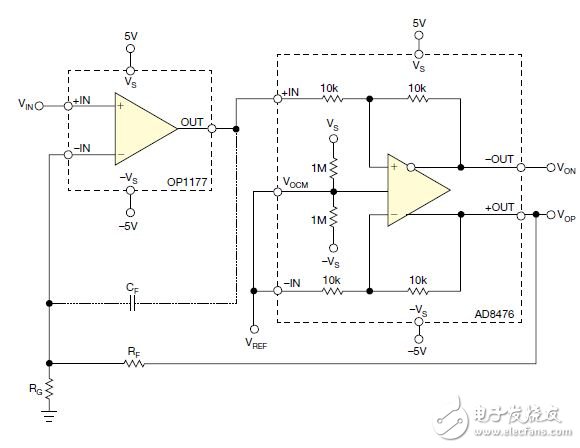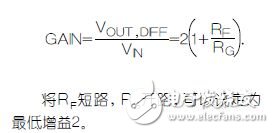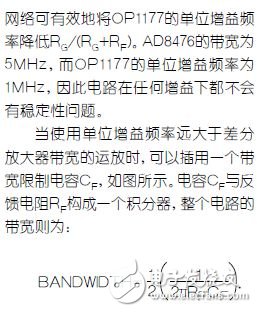Many applications require differential signals to achieve higher signal-to-noise ratios, improved common-mode noise rejection, and lower second-order harmonic distortion, such as driving modem ADCs, transmitting signals over twisted-pair cables, and High-fidelity audio signal adjustment, etc. This requires a circuit that converts a single-ended signal into a differential signal, a single-ended-differential converter. For many applications, the AD8476's built-in low-power, fully-differential precision amplifier is sufficient for single-ended-differential conversion. But for applications that require higher performance, an OP1177 precision op amp can be cascaded with the AD8476 as shown. This single-ended-differential converter has high input impedance, (maximum) 2nA input offset current and (maximum) 60μV offset voltage and (maximum) 0.7μV/°C voltage offset from the input. Figure 1: This single-ended-differential converter can be set by adjusting the ratio of RF to RG. The circuit in Figure 1 is a dual-amplifier feedback structure in which the op amp determines the accuracy and noise performance of the circuit, while the differential amplifier acts as a single-ended-differential conversion. This feedback structure rejects the AD8476's error, including noise, distortion, offset, and drift, which replaces the op amp feedback loop inside the AD8476 with the large open-loop gain of the op amp. Essentially, this structure uses the open-loop gain of the op amp for the input, attenuating the error of the AD8476. The external resistors RF and RG in the figure set the gain of the single-ended-differential amplifier, ie As with any feedback connection, great care must be taken to ensure system stability. The cascading of the OP1177 and the AD8476 forms a combined differential output op amp with an open-loop gain that is the product of the OP1177 open-loop gain and the AD8476 closed-loop gain. Therefore, the closed-loop bandwidth of the AD8476 adds one pole to the open-loop gain of the OP1177. To ensure stability, the bandwidth of the AD8476 should be higher than the unity gain frequency of the OP1177. When the closed-loop gain of the circuit is greater than 2, this requirement can be relaxed because the resistance feedback The reason for the bandwidth equation 1/2 coefficient is that the output of the circuit is based on single-ended feedback, not differential. Therefore, the feedback coefficient and bandwidth of the circuit are halved. If this reduced bandwidth is less than the closed loop bandwidth of the differential amplifier, the circuit will be stable. This bandwidth limiting technique can also open the RG to get a gain of 2.
We have carved a niche amongst the customers for offering broad range of Monocrystalline / Polycrystalline Solar Panels. We provide products to our patrons at affordable rates and have long functional life. These Polycrystalline Solar Panels uses solar energy for charging and uses that energy to function. We are admired amongst the patrons for offering products as per their demands.
Solar Panel,Solar Pv Panel,High Efficient Solar Panel,Solar Power Panels Delight Eco Energy Supplies Co., Ltd. , https://www.cndelight.com

